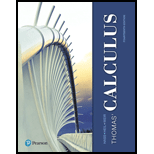
Thomas' Calculus (14th Edition)
14th Edition
ISBN: 9780134438986
Author: Joel R. Hass, Christopher E. Heil, Maurice D. Weir
Publisher: PEARSON
expand_more
expand_more
format_list_bulleted
Concept explainers
Question
Chapter A.3, Problem 7E
(a)
To determine
The equation of the vertical line through the point
(b)
To determine
The equation of the horizontal line through the point
Expert Solution & Answer
Want to see the full answer?
Check out a sample textbook solution
Students have asked these similar questions
The graph of f' is below. Use it to determine where the local minima and maxima for f are. If there
are multiple answers, separate with commas.
2
f'(x)
N
-5 -4 3-2-1
-1
-2
-3
-4
12 3 4 5
-x
Local minima at x
Local maxima at x
The graph of f' is below. Use it to determine the intervals where f is increasing.
-5-4-32
4-
3
2
1
-2
-3
+x
2
3 4 5
The graph of f' is below. Use it to determine where the inflection points are and the intervals where f
is concave up and concave down. If there are multiple inflection points, separate with a comma.
6
5
4
3
2
1
f'(x)
+x
-6-5-4-3 -2 -1
1 2 3 4 5
6
-1
-2
-3
-4
-5
-6+
Inflection point(s) at x =
Concave up:
Concave down:
Chapter A.3 Solutions
Thomas' Calculus (14th Edition)
Ch. A.3 - In Exercises 1 and 2, a particle moves from A to B...Ch. A.3 - Prob. 2ECh. A.3 - Describe the graphs of the equations in
Ch. A.3 - Prob. 4ECh. A.3 - Prob. 5ECh. A.3 - Prob. 6ECh. A.3 - Prob. 7ECh. A.3 - Prob. 8ECh. A.3 - Prob. 9ECh. A.3 - Prob. 10E
Ch. A.3 - Prob. 11ECh. A.3 - In Exercises 9–15, write an equation for each line...Ch. A.3 - Prob. 13ECh. A.3 - Prob. 14ECh. A.3 - Prob. 15ECh. A.3 - In Exercises 16 and 17, find the line’s x-and...Ch. A.3 - In Exercises 16 and 17, find the line’s x-and...Ch. A.3 - Is there anything special about the relationship...Ch. A.3 - Prob. 19ECh. A.3 - Prob. 20ECh. A.3 - Prob. 21ECh. A.3 - Prob. 22ECh. A.3 - Prob. 23ECh. A.3 - Prob. 24ECh. A.3 - Prob. 25ECh. A.3 - Prob. 26ECh. A.3 - Prob. 27ECh. A.3 - Prob. 28ECh. A.3 - Prob. 29ECh. A.3 - Prob. 30ECh. A.3 - Describe the regions defined by the inequalities...Ch. A.3 - Describe the regions defined by the inequalities...Ch. A.3 - Prob. 33ECh. A.3 - Describe the regions defined by the inequalities...Ch. A.3 - Prob. 35ECh. A.3 - Write a pair of inequalities that describe the...Ch. A.3 - Prob. 37ECh. A.3 - Prob. 38ECh. A.3 - Prob. 39ECh. A.3 - Prob. 40ECh. A.3 - Prob. 41ECh. A.3 - Insulation According to the figure in Exercise 41,...Ch. A.3 - 43. Pressure under water The pressure p...Ch. A.3 - Reflected light A ray of light comes in along the...Ch. A.3 - Prob. 45ECh. A.3 - Prob. 46ECh. A.3 - Prob. 47ECh. A.3 - Show that the triangle with vertices A(0, 0), ,...Ch. A.3 - Prob. 49ECh. A.3 - Prob. 50ECh. A.3 - Prob. 51ECh. A.3 - Prob. 52E
Knowledge Booster
Learn more about
Need a deep-dive on the concept behind this application? Look no further. Learn more about this topic, calculus and related others by exploring similar questions and additional content below.Similar questions
- The graph of f' is below. Use it to determine where the local minima and maxima for f are. If there are multiple answers, separate with commas. f'(x) 4- -5-4-3-8-1 3 2 1 x 1 2 3 4 5 -1 -2 -3 -4 Local minima at a Local maxima at =arrow_forwardThe graph of f' is below. Use it to determine the intervals where f is increasing. f'(xx) 4- -5 -3 -2 3 2 1 1 2 3 4 5 Cit +x 7 2arrow_forwardPlease focus on problem ii.arrow_forward
- Please focus on vi.arrow_forward的 v If A is an n x n matrix that is not invertible, then A. rank(A) = n C. det(A) = 0 B. Reduced row-echelon form of A = In D. AB BA= In for some matrix B 63°F Partly sunny Q Search 3 $ 4 40 FS 96 S W E A S T FG S Y & コ B ㅁ F G H J 4 Z X C V B N M 9 H V FIB - FIB ㅁ P L ว DELETE BACHSPACE LOCK L ? PAUSE ALT CTRL ENTER 7 2:20 PM 4/14/2025 HOME J INSERT SHIFT END 5arrow_forwardFor this problem just focus on problem i please.arrow_forward
arrow_back_ios
SEE MORE QUESTIONS
arrow_forward_ios
Recommended textbooks for you
 Calculus: Early TranscendentalsCalculusISBN:9781285741550Author:James StewartPublisher:Cengage Learning
Calculus: Early TranscendentalsCalculusISBN:9781285741550Author:James StewartPublisher:Cengage Learning Thomas' Calculus (14th Edition)CalculusISBN:9780134438986Author:Joel R. Hass, Christopher E. Heil, Maurice D. WeirPublisher:PEARSON
Thomas' Calculus (14th Edition)CalculusISBN:9780134438986Author:Joel R. Hass, Christopher E. Heil, Maurice D. WeirPublisher:PEARSON Calculus: Early Transcendentals (3rd Edition)CalculusISBN:9780134763644Author:William L. Briggs, Lyle Cochran, Bernard Gillett, Eric SchulzPublisher:PEARSON
Calculus: Early Transcendentals (3rd Edition)CalculusISBN:9780134763644Author:William L. Briggs, Lyle Cochran, Bernard Gillett, Eric SchulzPublisher:PEARSON Calculus: Early TranscendentalsCalculusISBN:9781319050740Author:Jon Rogawski, Colin Adams, Robert FranzosaPublisher:W. H. Freeman
Calculus: Early TranscendentalsCalculusISBN:9781319050740Author:Jon Rogawski, Colin Adams, Robert FranzosaPublisher:W. H. Freeman
 Calculus: Early Transcendental FunctionsCalculusISBN:9781337552516Author:Ron Larson, Bruce H. EdwardsPublisher:Cengage Learning
Calculus: Early Transcendental FunctionsCalculusISBN:9781337552516Author:Ron Larson, Bruce H. EdwardsPublisher:Cengage Learning

Calculus: Early Transcendentals
Calculus
ISBN:9781285741550
Author:James Stewart
Publisher:Cengage Learning

Thomas' Calculus (14th Edition)
Calculus
ISBN:9780134438986
Author:Joel R. Hass, Christopher E. Heil, Maurice D. Weir
Publisher:PEARSON

Calculus: Early Transcendentals (3rd Edition)
Calculus
ISBN:9780134763644
Author:William L. Briggs, Lyle Cochran, Bernard Gillett, Eric Schulz
Publisher:PEARSON

Calculus: Early Transcendentals
Calculus
ISBN:9781319050740
Author:Jon Rogawski, Colin Adams, Robert Franzosa
Publisher:W. H. Freeman


Calculus: Early Transcendental Functions
Calculus
ISBN:9781337552516
Author:Ron Larson, Bruce H. Edwards
Publisher:Cengage Learning
Use of ALGEBRA in REAL LIFE; Author: Fast and Easy Maths !;https://www.youtube.com/watch?v=9_PbWFpvkDc;License: Standard YouTube License, CC-BY
Compound Interest Formula Explained, Investment, Monthly & Continuously, Word Problems, Algebra; Author: The Organic Chemistry Tutor;https://www.youtube.com/watch?v=P182Abv3fOk;License: Standard YouTube License, CC-BY
Applications of Algebra (Digit, Age, Work, Clock, Mixture and Rate Problems); Author: EngineerProf PH;https://www.youtube.com/watch?v=Y8aJ_wYCS2g;License: Standard YouTube License, CC-BY